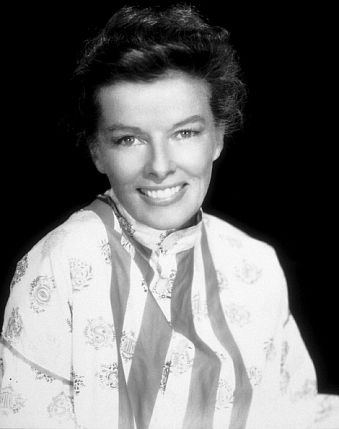|
Katharine Hepburn
Scroll down for movie list.
Biography from Leonard Maltin's Movie Encyclopedia:
She was branded "box-office poison" by the nation's exhibitors in 1938, but Katharine Hepburn has come to be regarded as a national treasure. One of the most frequently honored screen actresses (with eight Academy nominations and four Oscars to her credit), Hepburn came to films in A Bill of Divorcement (1932), as John Barrymore's daughter, following a sometimes tempestuous career on stage in amateur theatricals, college shows, stock, and finally on Broadway. Her unusual looks and manner-and her unique New England voice-put off some moviegoers at first, but her endearing performance as a naive, impulsive young actress trying to crash Broadway, in 1933's Morning Glory won her her first Academy Award. Hepburn proved her versatility in such pictures as Little Women (1933), The Little Minister (1934), Alice Adams (1935, for which she received an Oscar nomination), Mary of Scotland (1936), and the wonderful Stage Door (1937, an interesting companion piece to Morning Glory But for every success in her early Hollywood career, there was also a major misfireincluding such all-time oddities as Christopher Strong (1933, in which she played an aviatrix) and Sylvia Scarlett (1935, in which she disguised herself as a boy).
By the time she made the classic screwball comedy Bringing Up Baby (1938, for which the understandably nervous actress took comedy "pointers" from veteran screen funnyman Walter Catlett) and the equally delightful comedy-drama Holiday (also 1938), Hepburn's film career was on the skids. (Although it was that same year that Walt Disney immortalized her in cartoon form, as a haughty Little Bo-Peep in his animated short subjectMother Goose Goes Hollywood She returned to Broadway to star as spoiled socialite Tracy Lord in Philip Barry's "The Philadelphia Story," forsaking a huge salary for a percentage of profits and title to the screen rights. Her successful gamble paid off, and led to an equally triumphant return to Hollywood in the 1940 film version, which earned her another Oscar nomina tion. She was nominated again for her next film, Woman of the Year (1942) which cast her as an opinionated newspaper columnist opposite Spencer Tracy (as a down-to-earth sportswriter). It was a match made in movie heaven; the two would star in eight subsequent films over the next 25 years. (They also commenced an offscreen relationship that lasted until his death.)
Some of the early Tracy-Hepburn collaborations were heavy dramas such as Keeper of the Flame (1942) and The Sea of Grass (1947). Dramatic fireworks flew as well in State of the Union (1948), but the team is best remembered for its humorous skirmishes in the battle of the sexes with Without Love (1945), Adam's Rib (1949), Pat and Mike (1952), and Desk Set (1957). While Hepburn's work in the 1930s and 1940s receives the most attention today, many of the star's peak achievements were realized in the 1950s and 1960s. She picked up Oscar nominations for her work in The African Queen (1951, opposite Humphrey Bogart, as a missionary whose personality she patterned after Eleanor Roosevelt), Summertime (1955), The Rainmaker (1956), Suddenly, Last Summer (1959, as Elizabeth Taylor's shrewish, sinister aunt), and Long Day's Journey Into Night (1962). Offscreen for five years, she returned to costar with Tracy in Guess Who's Coming to Dinner (1967), which proved to be his final film; it won her a second Oscar. Hepburn received her third gold statuette the following year for her work in the period drama The Lion in Winter as Eleanor of Aquitaine, which showed the aging actress in full command of her inestimable talent. She followed this triumph by making her Broadway musical debut as couturier Coco Chanel in "Coco." Other films around this time include The Madwoman of Chaillot (1969), The Trojan Women (1972), and A Delicate Balance (1973).
A much-anticipated pairing of Hepburn with John Wayne yielded disappointing results, as Rooster Cogburn (1975) turned out to be a watered-down retread of The African Queen But her teaming with another screen giant, Henry Fonda, in On Golden Pond (1981), brought her a fourth Best Actress Academy Award, and proved to be her finest latter-day film. Hepburn's TV work has largely been confined to long-form dramas. She received Emmy nominations for Tennessee Williams' "The Glass Menagerie" (1973), and "The Corn Is Green" (1979), directed by her longtime friend and collaborator, George Cukor. She won an Emmy for "Love Among the Ruins" (1975), also directed by Cukor and costarring Laurence Olivier. Since that time she has starred in several "star-vehicle" TV movies, including Laura Lansing Slept Here (1988), The Man Upstairs (1992), and This Can't Be Love (1994). Her 1991 autobiography, "Me," was a best-seller, as was her more specific 1987 memoir, "The Making of The African Queen or How I Went to Africa with Bogart, Bacall and Huston and Almost Lost My Mind." After years away from the big screen, Hepburn was coaxed back to do Love Affair (1994); she provided that film's highlight, as Warren Beatty's aunt. |  |










